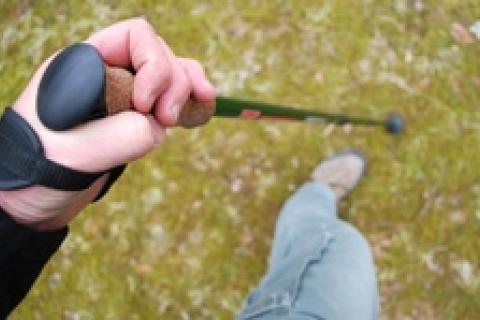
 I was one mile into the second 5-mile hike for the day, completing GPS and map work for a regional hiking guidebook I was writing. The trail lead to a abrupt, uphill climb, causing me to lean forward to accommodate the incline. It was then I realized that I had left my trekking poles back at the vehicle. I paused for a few seconds and debated whether or not I should retrieve the poles before going on. I was pressed for time so I pushed on. Mistake. The remaining 4 miles through rough terrain, including more uphill sprints and demanding declines, left my knee feeling a bit stressed from a sprain gained on another hike earlier in the week.
I was one mile into the second 5-mile hike for the day, completing GPS and map work for a regional hiking guidebook I was writing. The trail lead to a abrupt, uphill climb, causing me to lean forward to accommodate the incline. It was then I realized that I had left my trekking poles back at the vehicle. I paused for a few seconds and debated whether or not I should retrieve the poles before going on. I was pressed for time so I pushed on. Mistake. The remaining 4 miles through rough terrain, including more uphill sprints and demanding declines, left my knee feeling a bit stressed from a sprain gained on another hike earlier in the week.
It was only a couple years ago that I finally picked up a pair of trekking poles for a trial run. Like many hikers and backpackers, I to thought trekking poles were for older adventurers, those with leg ailments, or backpacking. At first I used one pole, figuring that would give me some stability on tough trail conditions. After only a couple hikes, I gave the second pole a chance — and liked it. Even with occasional comments such as, "Forget your skis?", from passing hikers, my trekking poles became constant trail companions. Not only do trekking poles give support to sore knees and ankles, they also are efficient tools to prevent such injuries and strains.
Trekking poles are much more than a fashion statement on the trail, or a joke considered by the uninformed. They have many uses. I'm cursed with a touch of clumsiness, so a trekking pole in each hand provides balance on narrow, tilted trails. I never cross a creek without the support of my two aluminum, adjustable trekking poles. The metal tips of the poles grip the creek bottom, mossy rocks and all which keeps ole clumsy-matic here from an unexpected dunking.
The best design that I have used are the telescopic type. By having length adjusting capabilities, the poles can be shared with others if need be. When descending, extend the poles a few inches to reach the ground as your body leans slightly back for balance. The poles also serve as brakes going downhill in this position. When climbing steep trails, shorten the poles from their level walking setting, so they fit your leaning forward posture while stepping up.
Trekking poles are a must while backpacking, and after using a set one time, you will likely agree that the poles have a place on a day hike as well. My trekking poles are used for all of the above and then some. I have even tried to use one to scoot a snake off the trail in front of me, but the pole wouldn't extend long enough for me to get the job done.
- 2802 views

